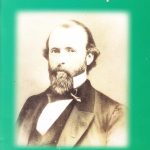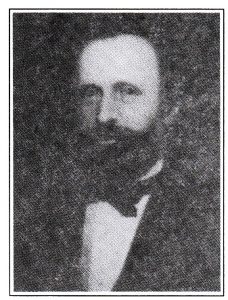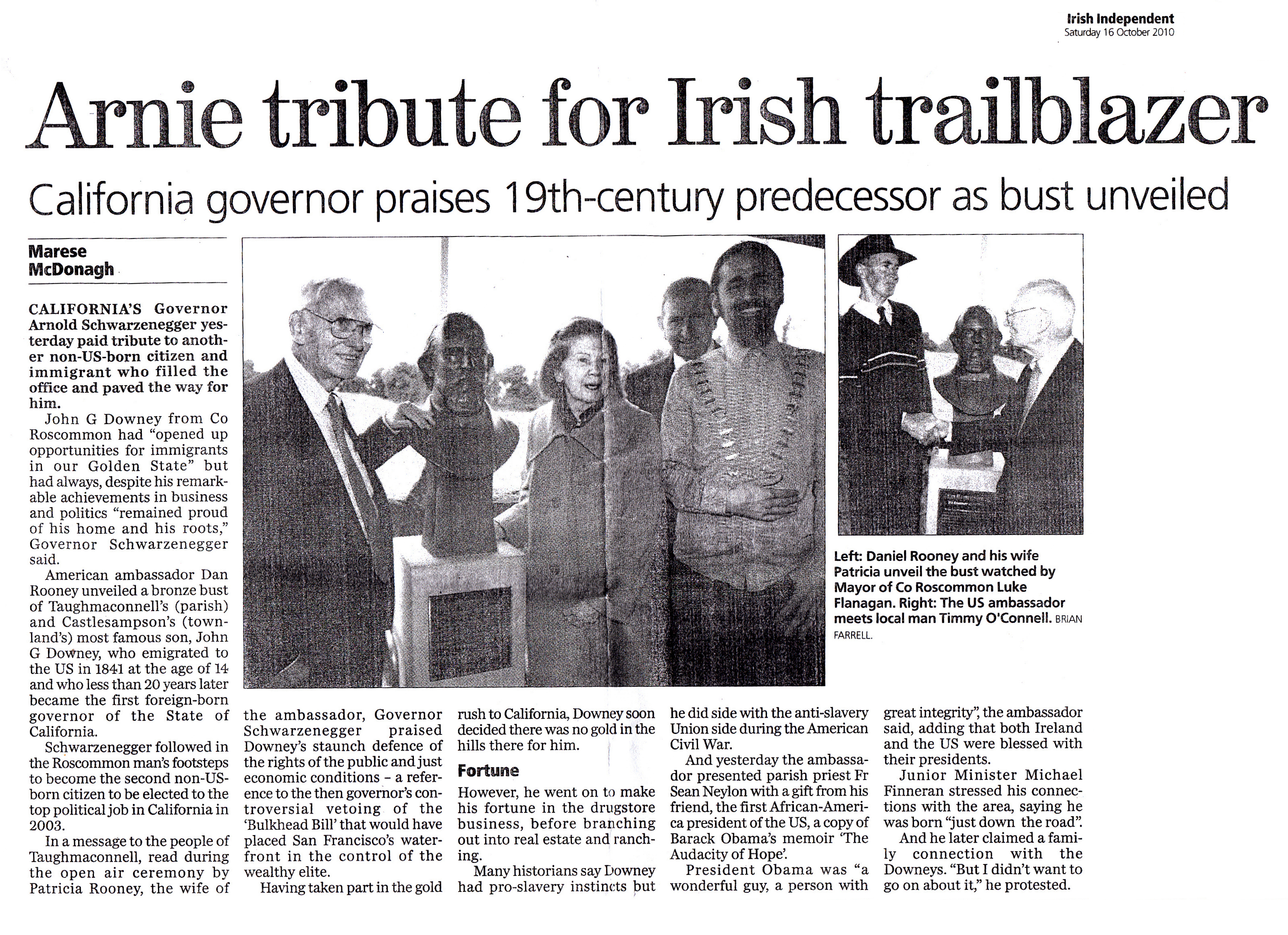John Gately Downey – Seventh Governor of California.
A native of Castlesampson.
Timeline with Endnote Article link
 Governor John G Downey. A South Roscommon Native – Taughmaconnell Heritage and Historical Society Publication Governor John G Downey
Governor John G Downey. A South Roscommon Native – Taughmaconnell Heritage and Historical Society Publication Governor John G Downey

John G Downey was born on June 24th, 1827 in his Grandfathers house at Castlesampson, Taughmaconnell. It was a cut-stone house and its barn was also of cut-stone. He was the son of Denis Downey but was also known as ‘honest jack’. His mother was Bridget Gately who was previously married to a John Martin.
John Downey set sail from cork in 1842 – his destination was Maryland, USA. He was not quite 16. His two older sisters Mary and Winifred had emigrated ten years earlier and had sent John the fifty dollars for his fare on condition he would finish his education in America. His mother had hopes that he might join the priesthood but John felt his vocation was to own many acres of land. He attended a Latin school until Easter 1843. His tutor told him that a friend was looking for a bright apprentice to work in his drug store in Washington. John worked 6 days a week and studied at night.
It was not long before John Downey brushed shoulders with the elite.
On February 22nd, 1844 John went, at the behest of his employer, on a
river Potomac aboard a warship called Princeton. The wife of the Secretary of the Navy was a regular customer at the drug store and had requested that medication be available on board should she need it. The passenger list included the President of the United States – President Tyler.
John Downey was still anxious to earn more money and move on
Mississippi. He remained there for about a year before being offered a job in Cincinnati by a Scotsman called John Darling; Downey jumped at the offer. A few weeks later he took up his new post. After only six months John Darling made John Downey a full partner in his small business in Cincinnati.
It was while he worked that John learned from newly arrived emigrants
famine in his homeland. For many months he feared for his mother and
sisters who remained at home in Ireland. After many months he receive
his mother saying that his Uncle Sean Ruagh and many of his school friends had dies of hunger but she and the girls were getting by. The hope of going to
them going.
In 1848 John Downey read an article in the “Cincinnati Post” of a gold find in
California. This, he thought, was the opportunity of a lifetime. He was stricken by “gold fever”. He would go there, and get rich and be able to bring his mother and sisters to America. The journey took almost three months in poor conditions and with a ragged bunch of travellers. John travelled with a group of about sixty walks of life. They finally sailed into the Golden Gate harbour of San Francisco. He made his way to Sacramento and from there to the Gold mines. He met several of his country men in the mines, mostly refugees from the famine in Ireland.
Having Spent three months up and down the Feather River with little success and with prosperity eluding him John returned to San Francisco. Here in what was supposed to be the “land of opportunity” he found himself in another dead-end job. He was a clerk in a drug store. He soon found that for every success story there were hundreds of people who found themselves impoverished with nowhere to go.
In 1850 John Downey went to Los Angeles to a man he had befriended
Francisco. Dr. MacFarland had written to Iohn telling him of the beauty of the place and the need for pharmaceutical products. Here he found success. His business boomed as the wagons passing to the gold mines went through the village.
John Downey became an American citizen in 1851 and sent money home to
his mother and two younger sisters to America. They travelled to Maryland, as
California was too long a journey. He became a moneylender as well as running his business and became quite wealthy. John met and married his wife Maria, who was of Spanish extraction. He went into real estate and saw his dream of owning many acres come true. By 1856 he was one of the wealthiest men in Los Angeles often donating money to charity and helping to set up various institutions in the area. He joined the Democratic Party and became increasingly involved in politics.
In 1859, Milton Latham, invited John to be his running mate in the forthcoming election for the governorship. The Latham/Downey campaign was successful. Five days later John became governor. Another Irishman, David Broderick had been murdered leaving a Senate seat vacant. Latham secured the Senate seat leaving the Governorship vacant for Downey. At the age of 33, in 1860, John Gately became the youngest governor of the state of California.
By 1861 the Civil War was on course. In July 1861, the Secretary of War called Downey for troops to guard the overland mail route. Downey replied positively. Those in Washington watched California closely knowing Downey’s opposition to bloody revolution. It would be impossible for the Union to defend the vast territory west of the Mississippi without California solidly behind the Union. Downey sent the first trans-continental telegram to President Lincoln stating “l will keep California safe for the Union”. By placing the state squarely on the side of the Union, he spared California the bitter experience of civil war within the Civil War. Downey realised he was committing political suicide by preserving the Union. He lost credibility his constituents in Southern California who were still with the Confederate side. He completed his term as Governor with a clear conscience and as expected was not nominated for a second term.
John and Maria returned to Los Angeles where they built a mansion that housed the city’s first private ballroom. Downey continued to work within the political system while his real estate business continued to flourish. He saw the great need for a banking system and along with a financier J A Howard of San Francisco, established the first bank in Los Angeles. He was instrumental in ensuring that a rail link connected San Francisco to Los Angeles rather than by-passing Los Angeles and going directly to New Orleans. In September 1876, the rail-link between San Francisco and Los Angeles was complete and John Downey had played a major part in its development.
Downey City, in Los Angeles County, Southern California, between the Rio Hondo and the San Gabriel River, near Los Angeles, is named after John Downey, Governor of California 1860-62.
The community was established with the arrival of the railroad and was an agricultural centre until the 1940s. Industries now include aerospace, electrical equipment and processed foods. It has a population of approximately 100,000 people.
John’s wife Maria died in a train accident in January 1883. John was injured but
recovered. However he became depressed and was a broken man. In September 1885 John along with two companions set out on a trip around the world, which included a visit to Ireland where he had a tombstone erected on his fathers grave in Thughmaconnell Old Cemetery.
In 1888 he married a Rose V. Kelly, who had also emigrated from Ireland in 1892. There were no children with either marriage. ]ohn Downey died on March 1st , 1894, leaving approximately 30,000 acres of land and other properties and wealth. He had traveled far and found his fortune. The last of Governor John Downey’s descendants, Pat Downey of Castlesampson died in the late 1990’s.



